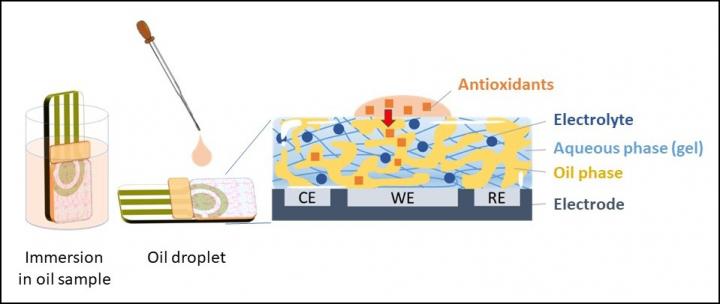A new sheet-type electrochemical antioxidant capacity measurement system for quick and easy results

Credit: Professor Masashi Kunitake
Researchers from Kumamoto University (Japan) have developed a system to quickly and easily measure the antioxidant capacity of food. The new electrochemical system uses a gel form Bicontinuous Microemulsion (BME), a mixture of water and oil that do not normally mix, integrated with a sheet-type electrode. This system can easily be used by anyone anywhere and is expected to be used for quality control in the production, manufacturing and sale of food products.
Some of the oxygen taken into the body is converted into highly reactive oxygen species (ROS). Excessive production of ROS can lead to arteriosclerosis, cancer, aging, and decreased immune function. Antioxidants inhibit the generation of ROS and their function, or can even remove ROS themselves. Fat-soluble antioxidants, such as vitamins and polyphenols, are easily soluble in oil rather than water. It is important to evaluate the antioxidant capacity of food to maintain a healthy diet, but conventional evaluation methods require complex separation, extraction, and colorimetric analysis, which makes it difficult to measure fat-soluble antioxidants in colorful or cloudy food samples.
Professor Masashi Kunitake’s research group has developed a new electrochemical system that allows easy measurement of antioxidant capacity anywhere. This was achieved by creating a new BME gel and integrating it with sheet electrodes to significantly simplify the measurement process.
Normally, an electrochemical analysis is taken by dissolving a sample into an electrolyte solution and measuring the currents from three electrodes (working, reference, & counter). In the new system, however, the gel membrane affixed to the electrodes acts as its own electrolyte solution. Even oily substances that are not soluble can be analyzed in their original state without separation and extraction. The system’s electrodes are simply dipped into the sample or a drop of the sample is placed on the electrode–no extensive equipment or special treatment required. The antioxidant capacity of the sample can now be easily assessed without the complexities previously performed in the laboratory. This system has already been used to measure vitamin E in commercial olive oil as proof of concept.
“Our system can be used for quality control of meat, fish, vegetables, fruits, chocolate, cosmetics, and other products at production, manufacturing, and retail outlets,” said Professor Kunitake. “If the analysis of food products becomes more accessible to producers and consumers, it could give added value to food products, help find the best cultivation conditions for production, and eventually become a criterion for judging whether food products are both tasty and safe to eat. We hope that this system will contribute to increased healthy food production for society.”
###
This research was posted online in Analytical Chemistry on 17 September 2020.
Source:
Hashimoto, H., Goto, K., Sakata, K., Watanabe, S., Kamata, T., Kato, D., … Kunitake, M. (2020). Stand-Alone Semi-Solid-State Electrochemical Systems Based on Bicontinuous Microemulsion Gel Films. Analytical Chemistry, 92(20), 14031-14037. doi:10.1021/acs.analchem.0c02948
Media Contact
J. Sanderson & N. Fukuda
[email protected]
Related Journal Article
http://dx.




